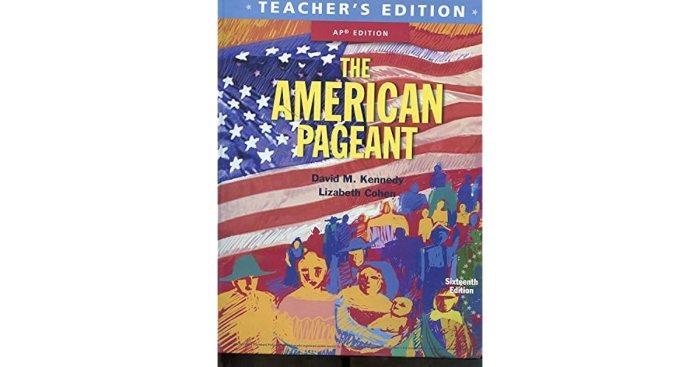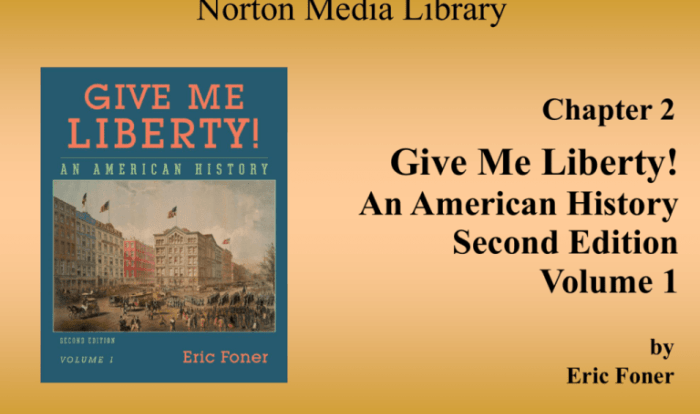The American Pageant Chapter 29 delves into the transformative era following World War II, a period marked by both challenges and triumphs. Join us as we explore the intricate tapestry of American history during this pivotal time.
This chapter delves into the domestic and international complexities faced by the United States, examining the impact of the Cold War on foreign policy and social fabric. We’ll also trace the rise of conservatism and the Civil Rights Movement, highlighting their profound influence on American society.
The American Pageant: A History of the United States, Chapter 29
Chapter 29 of “The American Pageant” examines the pivotal era of American history spanning the late 19th and early 20th centuries. This period witnessed significant economic, social, and political transformations that shaped the nation’s identity and global standing.
Major Themes and Events
The chapter delves into key themes and events, including the rise of industrialization, urbanization, and immigration. It explores the challenges and opportunities these developments posed for American society, as well as the emergence of new social and economic ideologies.
Author’s Perspective
The author presents a balanced perspective on this complex period, acknowledging both the progress and setbacks experienced by the nation. While highlighting the economic growth and technological advancements, the chapter also examines the social inequalities, political corruption, and international tensions that characterized the era.
s
- The Gilded Age: Economic Growth and Inequality
- Urbanization and Immigration
- Social Reform and Progressivism
- Imperialism and Foreign Policy
- The Progressive Era
The Post-World War II Era
The end of World War II marked a transformative period for the United States. The nation emerged from the conflict as a global superpower, but it also faced numerous domestic and international challenges. The Cold War, a decades-long rivalry with the Soviet Union, shaped American foreign policy and domestic affairs.
Additionally, the United States experienced significant social and cultural changes during this era.
Domestic Challenges
In the aftermath of the war, the United States faced a number of domestic challenges. The economy had to be reconverted from wartime production to peacetime production. The nation also had to address the needs of returning veterans, who had been away from home for years.
Additionally, the United States had to grapple with the issue of racial inequality, which had been brought to the forefront by the war.
International Challenges
The United States also faced a number of international challenges in the aftermath of World War II. The Soviet Union emerged from the war as a major power, and the two nations soon became rivals in the Cold War. The United States also had to deal with the aftermath of the war in Europe and Asia.
Additionally, the United States had to confront the rise of communism in China and elsewhere.
The Cold War
The Cold War was a decades-long rivalry between the United States and the Soviet Union. The conflict was primarily ideological, with the United States representing capitalism and democracy and the Soviet Union representing communism. The Cold War shaped American foreign policy and domestic affairs for decades.
Social and Cultural Changes
The United States also experienced significant social and cultural changes during the post-World War II era. The war had a profound impact on American society, and the nation emerged from the conflict with a new sense of confidence and optimism.
The United States also saw a number of social and cultural changes during this era, including the rise of the suburbs, the baby boom, and the civil rights movement.
The Rise of Conservatism and the Civil Rights Movement
The post-World War II era in the United States witnessed a surge in conservative political ideologies alongside the rise of the Civil Rights Movement. This period was characterized by significant societal and political shifts that shaped the nation’s landscape.
The Rise of Conservatism
The conservative movement in the post-war era was fueled by several factors, including:
- Economic Anxiety:The post-war economic boom led to a widening gap between the wealthy and the working class, creating economic anxiety among many Americans.
- Fear of Communism:The Cold War fueled fears of communist infiltration and subversion, which conservatives saw as a threat to traditional American values.
- Disillusionment with Liberalism:Some Americans grew disillusioned with the perceived failures of New Deal liberalism, believing it had led to excessive government intervention and weakened individual responsibility.
The Civil Rights Movement
The Civil Rights Movement emerged as a response to the persistent racial discrimination and segregation faced by African Americans in the United States. Key events and leaders of the movement included:
- Brown v. Board of Education (1954):This Supreme Court ruling declared school segregation unconstitutional, marking a major victory for the Civil Rights Movement.
- Martin Luther King Jr.:A prominent leader of the movement, known for his nonviolent resistance and advocacy for racial equality.
- Montgomery Bus Boycott (1955-1956):A successful boycott led by Rosa Parks and Martin Luther King Jr. that desegregated public transportation in Montgomery, Alabama.
- Civil Rights Act of 1964:A landmark legislation that outlawed discrimination based on race, color, religion, sex, or national origin.
These movements profoundly influenced American society and politics, shaping the nation’s social fabric and political landscape.
The Vietnam War and Its Impact on American Society
The Vietnam War, a protracted and controversial conflict, profoundly impacted American society. Its origins lie in the Cold War’s geopolitical rivalry and the post-colonial struggle in Southeast Asia. The war’s major battles, including the Tet Offensive and the Battle of Khe Sanh, shaped its course and public perception.
Causes of the Vietnam War
- Domino Theory: The belief that if one Southeast Asian country fell to communism, others would follow.
- Cold War Rivalry: The United States and the Soviet Union sought to expand their spheres of influence globally.
- Nationalism in Vietnam: The Vietnamese people sought independence from French colonial rule and later resisted the communist North.
Major Battles and Turning Points
- Gulf of Tonkin Incident (1964): Alleged North Vietnamese attacks on American ships led to the escalation of U.S. involvement.
- Tet Offensive (1968): A surprise attack by North Vietnamese forces weakened public support for the war.
- My Lai Massacre (1968): The killing of hundreds of civilians by American soldiers further eroded public confidence.
- Paris Peace Accords (1973): Ended American involvement and established a ceasefire, but the war continued until 1975.
Impact on American Society
The Vietnam War had a profound impact on American society:
- Political:The war led to protests and divisions within American society, contributing to the anti-war movement and the decline of the presidency.
- Cultural:The war challenged traditional values and norms, influencing music, literature, and film, and contributing to a counterculture movement.
- Foreign Policy:The war eroded public trust in the government and its foreign policy, leading to a more cautious approach to international conflicts.
Lessons Learned from the Vietnam War, The american pageant chapter 29
The Vietnam War taught the United States valuable lessons about the limitations of military intervention and the importance of clear objectives and public support:
- The importance of public consensus and clear war aims.
- The need for careful consideration of the potential costs and consequences of military intervention.
- The importance of respecting the sovereignty and self-determination of other nations.
These lessons continue to shape American foreign policy and inform contemporary debates about international conflicts.
The Era of Watergate and the End of the Cold War: The American Pageant Chapter 29
The Watergate scandal was a major political scandal that occurred in the United States during the 1970s. It involved the break-in of the Democratic National Committee headquarters at the Watergate office complex in Washington, D.C., and the subsequent cover-up of the incident by the Nixon administration.
The scandal led to the resignation of President Richard Nixon and a loss of trust in the government by the American people.
Key Figures in the Watergate Scandal
- Richard Nixon: President of the United States at the time of the scandal
- H.R. Haldeman: White House Chief of Staff
- John Ehrlichman: White House Counsel
- John Mitchell: Attorney General of the United States
- G. Gordon Liddy: Counsel to the Committee to Re-Elect the President (CRP)
- E. Howard Hunt: Former CIA officer and CRP operative
Impact of Watergate on American Politics
The Watergate scandal had a profound impact on American politics. It led to a loss of trust in the government and a decline in the popularity of President Nixon. The scandal also led to the passage of a number of laws designed to prevent future abuses of power by the executive branch, including the Ethics in Government Act of 1978 and the War Powers Act of 1973.
The End of the Cold War
The Cold War was a period of geopolitical tension between the United States and the Soviet Union and their respective allies. The Cold War began after World War II and lasted until the collapse of the Soviet Union in 1991. The Cold War was characterized by a series of proxy wars, arms races, and diplomatic crises.
Factors that Led to the End of the Cold War
- The economic and political decline of the Soviet Union
- The rise of Mikhail Gorbachev as leader of the Soviet Union
- The Reagan administration’s policy of containment and rollback
- The collapse of the Berlin Wall in 1989
Implications of the End of the Cold War
The end of the Cold War had a profound impact on the global order. It led to the collapse of the Soviet Union and the emergence of the United States as the sole superpower. The end of the Cold War also led to a period of increased cooperation between the United States and Russia.
Common Queries
What were the key factors contributing to the rise of conservatism in the post-war era?
Economic anxieties, fears of communism, and a desire for a return to traditional values played significant roles.
How did the Vietnam War impact American society?
The war led to widespread social unrest, political polarization, and a decline in public trust in government.
What were the key lessons learned from the Vietnam War?
The war highlighted the importance of avoiding military interventions without clear objectives and the need for public support for foreign policy decisions.

